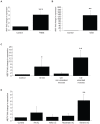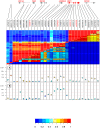Genetic variation in the familial Mediterranean fever gene (MEFV) and risk for Crohn's disease and ulcerative colitis
- PMID: 19784369
- PMCID: PMC2745755
- DOI: 10.1371/journal.pone.0007154
Genetic variation in the familial Mediterranean fever gene (MEFV) and risk for Crohn's disease and ulcerative colitis
Abstract
Background and aims: The familial Mediterranean fever (FMF) gene (MEFV) encodes pyrin, a major regulator of the inflammasome platform controlling caspase-1 activation and IL-1beta processing. Pyrin has been shown to interact with the gene product of NLRP3, NALP3/cryopyrin, also an important active member of the inflammasome. The NLRP3 region was recently reported to be associated with Crohn's disease (CD) susceptibility. We therefore sought to evaluate MEFV as an inflammatory bowel disease (IBD) susceptibility gene.
Methodology and results: MEFV colonic mucosal gene expression was significantly increased in experimental colitis mice models (TNBS p<0.0003; DSS p<0.006), in biopsies from CD (p<0.02) and severe ulcerative colitis (UC) patients (p<0.008). Comprehensive genetic screening of the MEFV region in the Belgian exploratory sample set (440 CD trios, 137 UC trios, 239 CD cases, 96 UC cases, and 107 healthy controls) identified SNPs located in the MEFV 5' haplotype block that were significantly associated with UC (rs224217; p = 0.003; A allele frequency: 56% cases, 45% controls), while no CD associations were observed. Sequencing and subsequent genotyping of variants located in this associated haplotype block identified three synonymous variants (D102D/rs224225, G138G/rs224224, A165A/rs224223) and one non-synonymous variant (R202Q/rs224222) located in MEFV exon 2 that were significantly associated with UC (rs224222: p = 0.0005; A allele frequency: 32% in cases, 23% in controls). No consistent associations were observed in additional Canadian (256 CD trios, 91 UC trios) and Scottish (495 UC, 370 controls) sample sets. We note that rs224222 showed marginal association (p = 0.012; G allele frequency: 82% in cases, 70% in controls) in the Canadian sample, but with a different risk allele. None of the NLRP3 common variants were associated with UC in the Belgian-Canadian UC samples and no significant interactions were observed between NLRP3 and MEFV that could explain the observed flip-flop of the rs224222 risk allele.
Conclusion: The differences in association levels observed between the sample sets may be a consequence of distinct founder effects or of the relative small sample size of the cohorts evaluated in this study. However, the results suggest that common variants in the MEFV region do not contribute to CD and UC susceptibility.
Conflict of interest statement
Figures


Similar articles
-
The association of inflammatory bowel disease and Mediterranean fever gene (MEFV) mutations in Turkish children.Dig Dis Sci. 2010 Dec;55(12):3488-94. doi: 10.1007/s10620-010-1178-5. Epub 2010 Mar 21. Dig Dis Sci. 2010. PMID: 20306331
-
Increased frequency of mutations in the gene responsible for familial Mediterranean fever (MEFV) in a cohort of patients with ulcerative colitis: evidence for a potential disease-modifying effect?Dig Dis Sci. 2006 Apr;51(4):687-92. doi: 10.1007/s10620-006-3192-1. Dig Dis Sci. 2006. PMID: 16614989
-
The cumulative effects of MEFV gene polymorphisms and mutations in patients with inflammatory bowel diseases.J Pak Med Assoc. 2021 Feb;71(2(A)):479-483. doi: 10.47391/JPMA.762. J Pak Med Assoc. 2021. PMID: 33819232
-
MEFV Mutations in IBD Patients: A Systematic Review and Meta- analysis.J Gastrointestin Liver Dis. 2022 Mar 19;31(1):85-97. doi: 10.15403/jgld-4070. J Gastrointestin Liver Dis. 2022. PMID: 35306551
-
The regulation of MEFV expression and its role in health and familial Mediterranean fever.Genes Immun. 2011 Oct;12(7):497-503. doi: 10.1038/gene.2011.53. Epub 2011 Jul 21. Genes Immun. 2011. PMID: 21776013 Review.
Cited by
-
Two Genetic Variations in the IRF8 region are associated with Behçet's disease in Han Chinese.Sci Rep. 2016 Jan 22;6:19651. doi: 10.1038/srep19651. Sci Rep. 2016. PMID: 26794091 Free PMC article.
-
Exaggerated IL-15 and Altered Expression of foxp3+ Cell-Derived Cytokines Contribute to Enhanced Colitis in Nlrp3-/- Mice.Mediators Inflamm. 2016;2016:5637685. doi: 10.1155/2016/5637685. Epub 2016 Aug 17. Mediators Inflamm. 2016. PMID: 27610005 Free PMC article.
-
Real-Life Indications of Interleukin-1 Blocking Agents in Hereditary Recurrent Fevers: Data From the JIRcohort and a Literature Review.Front Immunol. 2021 Nov 11;12:744780. doi: 10.3389/fimmu.2021.744780. eCollection 2021. Front Immunol. 2021. PMID: 34858402 Free PMC article. Review.
-
Recent Advance in Very Early Onset Inflammatory Bowel Disease.Pediatr Gastroenterol Hepatol Nutr. 2019 Jan;22(1):41-49. doi: 10.5223/pghn.2019.22.1.41. Epub 2019 Jan 10. Pediatr Gastroenterol Hepatol Nutr. 2019. PMID: 30671372 Free PMC article. Review.
-
The Role of Familial Mediterranean Fever Gene Mutation in Treatment of Infantile Colitis With Resistant Perianal Fistula.Arch Rheumatol. 2018 Mar 23;33(4):473-477. doi: 10.5606/ArchRheumatol.2018.6741. eCollection 2018 Dec. Arch Rheumatol. 2018. PMID: 30874249 Free PMC article.
References
Publication types
MeSH terms
Substances
Grants and funding
- DK064869/DK/NIDDK NIH HHS/United States
- AI065687/AI/NIAID NIH HHS/United States
- WT_/Wellcome Trust/United Kingdom
- AI067152/AI/NIAID NIH HHS/United States
- U01 DK062432/DK/NIDDK NIH HHS/United States
- R01 DK064869/DK/NIDDK NIH HHS/United States
- DK624230/DK/NIDDK NIH HHS/United States
- 072789/Z/03/Z/WT_/Wellcome Trust/United Kingdom
- G0800759/MRC_/Medical Research Council/United Kingdom
- CZB/4/540/CSO_/Chief Scientist Office/United Kingdom
- P01 AI065687/AI/NIAID NIH HHS/United States
- G0800675/MRC_/Medical Research Council/United Kingdom
- DK062432/DK/NIDDK NIH HHS/United States
- G0600329/MRC_/Medical Research Council/United Kingdom
- U19 AI067152/AI/NIAID NIH HHS/United States
LinkOut - more resources
Full Text Sources
Medical

